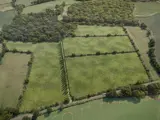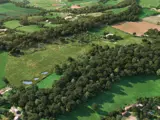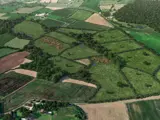Cornwell Habitat Bank, Oxfordshire
Local planning authority (LPA): West Oxfordshire District Council
National Character Area (NCA): Cotswolds
Biodiversity Units available:
Very high distinctiveness habitats
- Lowland meadows
High distinctiveness habitats
- Ponds (priority habitat)
- Floodplain wetland mosaic and CFGM
Medium distinctiveness habitats
- Mixed scrub
- Other neutral grassland
- Species-rich native hedgerow with trees
We’re transforming more than 30 hectares of pasture and arable land into a nature restoration site in the Cotswolds. Our Cornwell Habitat Bank is bordered by streams, wetland, woodland, and hedgerows, making our site a vital place to build connectivity for key species to build in abundance.
Following a thorough assessment of the site's vegetation, wildlife, geology, hydrology, soil chemistry, management history, and landscape connectivity, we determined the best possible habitats to establish and made sure these enhancements would be deliverable. We established an ecological baseline for the site using Defra’s biodiversity metric, so we can clearly demonstrate biodiversity gains over time.
This assessment enables us to generate a range of high-integrity Biodiversity Unit habitat types that will ensure robust ecological outcomes. We also offer planning support to make sure our Biodiversity Units provide an effective local BNG delivery solution for developers within the West Oxfordshire District Council LPA area or Cotswolds NCA. Our Units are ready to purchase now, subject to availability.
Adjacent LPAs for cross-boundary coverage:
- Cherwell District Council
- Cotswold District Council
- Stratford-on-Avon District Council
- Vale of White Horse District Council
Adjacent NCAs for cross-boundary coverage:
- Avon Vales
- Mendip Hills
- Dunsmore and Feldon
- Severn and Avon Vales
- Upper Thames Clay Vales
- Northamptonshire Uplands
- Yardley-Whittlewood Ridge
- Bristol, Avon Valleys and Ridges
- Bedfordshire and Cambridgeshire Claylands
Our Cornwell Habitat Bank partially lies within the nature ‘Recovery Zone,’ as identified by the Draft Oxfordshire Nature Recovery Network. Several protected and notable species have been identified within the site, including lapwing, kingfisher, great crested newt, and brown hare.
The Habitat Bank also contains Local Biodiversity Action Plan habitats, including coastal and floodplain grazing marsh and ponds. As part of the project, the grazing marsh is being enhanced to contain greater floristic diversity and newly created scrapes. Existing grassland and arable areas are being transformed into beautiful meadows, rich in native flora, mixed scrub, and a new pond – building an essential home for nature to thrive.
The site includes a Public Right of Way (PRoW), meaning that the local community will be able to observe as the Habitat Bank continues to grow and develop as a nature haven for the coming decades – truly enhancing their access to nature.
Areas of the Habitat Bank fall within flood zones. It is hoped that new scrapes within the grazing marsh, increased vegetation cover, and soil health enhancements will reduce surface water runoff and increase the soil’s water storage capacity, increasing the Habitat Bank’s resilience to climate change.
Find out the cost and availability of Biodiversity Units from our Cornwell Habitat Bank





